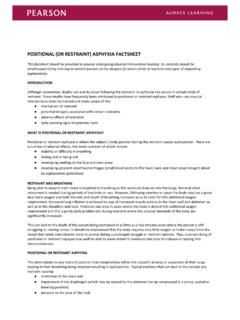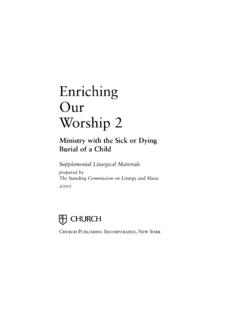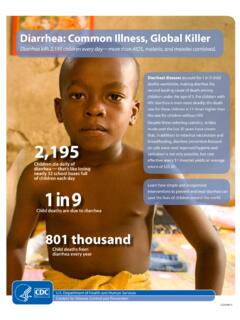Transcription of Information for Patients and Families About Feeding Tubes
1 What is a Feeding tube? A Feeding tube carries liquid nutrition, fluids, and medications directly into your stomach or intestines. One kind of Feeding tube goes into the nose, down through the throat, and into the stomach. It is About one-eighth of an inch in diameter. Another kind of Feeding tube goes through your skin into your stomach or intestines. Putting in the tube requires a minor procedure or surgery. When might a Feeding tube be considered? A Feeding tube might be considered if you: Can t eat enough to meet your body s need for nutrition Can t eat safely due to swallowing problems These problems might happen if you are very sick, have brain damage, or have a health problem that affects your nerves and muscles.
2 If you are expected to recover the ability to eat and swallow, a Feeding tube might be considered for a short time. If you are not expected to recover the ability to eat and swallow, a permanent Feeding tube might be considered. Sometimes people who have trouble eating on their own (for example, someone with dementia or muscle weakness) can get more nutrition when someone helps feed them. In those cases, a Feeding tube might not be needed. If you have a severe illness that cannot be cured and gets worse over time, getting weaker and not being able to eat enough on your own can be a sign that you are getting closer to dying .
3 Some diseases, in the very late stages, cause your organs to stop processing food and water normally. In those cases, a Feeding tube might not help you feel better or live longer. Feeding TubesFeeding Tubes Page 1 Information for Patients and Families About Page 2 What are some possible benefits of a Feeding tube? Depending on your condition, a Feeding tube might prolong your life. When your swallowing problem is expected to get better, having a Feeding tube for a short time can help improve your nutrition. For example, a short-term Feeding tube might help if you are recovering from a surgery or receiving a treatment that makes your throat very sore.
4 Long-term Feeding Tubes can help if your swallowing problem is caused by damage to your nerves or muscles. You do not need to be in a hospital to receive fluid and nutrition through a Feeding tube. With some swallowing problems, there is a danger that food or fluids could go down the wrong pipe and go into your lungs. It is not clear that Feeding Tubes help reduce this risk. Benefits and Risks What are some possible risks of a Feeding tube? Feeding Tubes can cause bleeding, infection, skin irritation, leaking around the tube, nausea, vomiting, and diarrhea. The tube can get blocked or fall out, and need to be replaced in a hospital.
5 You might find the tube to be uncomfortable. You might inhale fluid into your lungs with a Feeding tube. This could cause pneumonia. Depending on your condition, the Feeding tube may not help you feel better, gain weight, become stronger, or live longer. There is no evidence that Feeding Tubes help people live longer when they are in the last stages of a severe and incurable illness such as dementia or cancer. Feeding Tubes Page 2 Page 3 What if I have trouble eating or swallowing and I have a Feeding tube? If you are awake and aware of what s going on, having a tube down your nose and throat can be somewhat uncomfortable.
6 It is usually not painful, and many people get used to it over time. Having a tube that is placed through your stomach wall is not usually painful, and you can hide it under your clothes. It is harder to get around when liquid is flowing through the Feeding tube. If you get confused, you might pull on the Feeding tube. To prevent this from happening, you might be given medication to make you sleepy, you might have cloth wrapped around your mid-section to keep the tube in place, or you might have your hands covered or restrained. You would receive care to help you be as comfortable as possible. What to Expect Feeding Tubes Page 3 Page 4 What if I have trouble eating or swallowing and I do not have a Feeding tube?
7 Sometimes people who have trouble eating enough on their own can get more nutrition when someone helps them eat. You might continue to take in your favorite food and drinks, with help if needed, as long as you wanted to eat and were able to do so. You would receive care to help you be as comfortable as possible. Without fluids or nutrition at all, some people might feel hungry or thirsty at first and others may not. You might be given ice chips and mouth swabs to keep your lips moist. The amount of time a person can survive without food depends on their health, body weight, and whether or not they are taking in fluids.
8 Some people who are not eating at all but are taking sips of water have been known to live up to 20-40 days. Some people who are eating small amounts and drinking fluids might live for years. Without any fluid people might die within days to weeks. In the last stages of severe, incurable illness, when death is near and a person is no longer taking in food or water by mouth, Families often worry that the person will starve to death. In fact, for people with those medical problems, no longer taking in food and water is a natural, non-painful part of the dying process. In this case, the person is not dying because they have stopped eating, rather they have stopped eating because they are in the dying process.
9 Your health care team can tell you if you are at risk for problems ith eating or swallowing. Talk with them About treatment options that will support your goals and preferences. wYou would receive care to help you be as comfortable as possible. What to Expect Feeding Tubes Page 4






